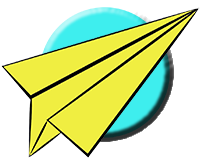Make an Incredible Oak Paper Airplane
Make an Incredible Oak Paper Airplane
Instructions
1. Make a crease to fold the right edge of the paper over so the new flap is exactly one-third of the paper's width. This is a tricky fold, take some time to get the proportions right.
2. Fold the right edge of the paper over so the flap created previously is folded exactly in half.
3. Fold the right edge of the paper over again so the flap created previously is folded exactly in half. The right side of the paper should now have eight layers.
4. Unfold all of the folds made previously so the paper is completely opened up and flat on the working surface.
5. Fold the paper in half about the existing crease second from the left hand edge of the paper. The paper should fold exactly in half if the previous folds were made in the right proportions.
6. Fold the upper layer of the paper over the top of itself about the existing crease first from the right edge of the paper.
7. Fold the right side of the paper over about the existing crease third from the right edge of the paper.
8. Rotate the paper around so the flaps just created are up and the paper's long edge is horizontal.
9. Fold the upper left corner down so the upper left point hits the existing crease second from the top. When folded correctly, the left edge should line up with the existing crease second from the top. Unfold after the crease has been made.
10. Switch to the right side of the paper.
11. Fold the upper right corner down so the upper right point hits the existing crease second from the top. When folded correctly, the right edge should line up with the existing crease second from the top. Unfold after the crease has been made.
12. Unfold the top layer of the paper so it is flat on the working surface.
13. Pop the left and right triangular creases up, in, and down while folding the top edge of the paper over and down. When folded correctly, the triangular flaps should be tucked in and underneath the top layer.
15. Fold the top layer over to the left about the existing crease first from the left. Pop the upper and lower points of the top flap over and down so they hit the right edge of the layer at the paper's middle. Two new creases are created as the fold is pressed flat.14. Rotate the paper around so the flaps just created are on the left.
16. Fold the lower left and upper right inner points of the top-most triangular flaps over so the points hit the existing crease first from the top. Bring the outer points of the top-most flap in as the fold pressed flat. Two new creases are created.
17. Fold the right edge of the flap at the center of the paper over about the existing crease.
18. Fold the upper flap over about the existing crease.
19. Flip the paper over and spin it around so the flaps are towards the top.
20. Fold the top edge of the paper over so the upper left point hits the existing crease first from the top. When folded correctly, several layers of paper are left to form the triangular section in the upper left. The lower left corner hits the paper's bottom edge.
21. Shift to the right side of the paper.
22. Make an identical crease on the right side. Fold the right edge of the paper over so the upper right. The lower right corner hits the paper's bottom edge.
23. Fold the right edge of the paper over about the existing crease first from the right.
24. Flip the paper over so the flap just created is underneath.
25. Fold the paper exactly in half about its short edge.
26. Make a crease to form the first wing flap. The left point of the crease should be about one finger width from the bottom edge of the fuselage and the right point should be about a quarter finger width from the bottom edge of the fuselage.
27. Fold the wing flap back over on top of itself. The left point of the new crease should be about one finger width down from the top edge and the right point should be about three finger widths down.
28. Fold the lower right point of the top-most layer up and over. The left point of the crease should be where the layer goes underneath the left edge flaps and the right point should be at the layer's edge.
29. Flip the plane over so the wing flaps just created are underneath and the nose is to the right.
30. Make a crease for the second wing flap. Be sure to line up the wing flaps for good balance and flying.
31. Fold the wing flap back over on top of itself. Be sure to line up with the fold from the first wing flap for good balance.
32. Fold the lower left point of the top-most layer up and over. Be sure to line up with the fold form the firs wing flap for good balance.
33. Open up the wing flaps and adjust the wing angles so they are even. The dihedral should be set strongly downward with the crease in the middle of the wing just as sharply upward. The small flaps at the wing ends can be adjusted for fined tuning the flight path by trial and error.
THE THROW Launch with a moderate to hard throw. This craft is a reliable flyer, quite stable, and can glide long distances. It can handle a hard throw at a down angle or be made to do loops if the wing flaps are properly adjusted.
